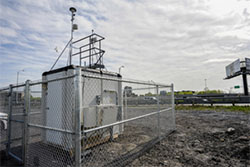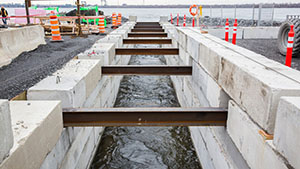Samuel De Champlain Bridge - Measures to protect the environment and the community during the Samuel De Champlain Bridge corridor project
During the project's environmental assessment, the Government of Canada listened to the concerns of residents living near the project area. Key issues raised by the public included the impact of dust and noise during the construction period and the environmental impact of operating the bridge once built, and the impact of construction on the archaeological site on Île-des-Soeurs known as the "LeBer site".
Various measures were put in place to minimize the project's environmental impact and effect on community residents related to:
- Noise Levels
- Air Quality
- Environmental Mitigation Programs
- Environmental Impacts Offset Programs
- Targeted Environmental Assessment: Fish Habitat
- Protection of Archaeological Heritage
Further information on the measures being taken to protect the environment and the community throughout the project is available on SSL's website.
Noise levels
Pre-Construction Mitigation Measures
- Noise sensitive areas were identified throughout the project corridor.
- The project design includes noise barriers in noise-sensitive areas.
Construction-Period Mitigation Measures
- Project specific noise thresholds were developed during the environmental assessment to take into consideration existing ambient noise. These will be respected throughout the construction period. Different thresholds were established for the day, evening and late night.
- Temporary noise barriers will be installed during the construction period when machinery reaches a noise level that exceeds these thresholds.
- Construction-site facilities will be used to block sound dispersion (for example, work trailers will be placed between the construction site and sensitive sound areas).
- Mufflers will be installed on noisy equipment (for example, jackhammers will be covered with insulating tarps).
- When possible, permanent noise barriers will be installed before construction begins to maintain the appropriate noise levels.
- Once the corridor is open to traffic, other permanent noise barriers will be installed as necessary to address specific noise thresholds that exceed the standards set by the Quebec Ministry of Sustainable Development, Environment and the Fight against Climate Change.
Monitoring and Follow-up
- Noise levels during construction will be monitored and measured by noise sampling stations located five metres from sensitive areas over 24-hour periods using calibrated sound level meters, which will be moved as the work progresses.
- When the bridge becomes operational, acoustic monitoring will be conducted after one, five and 10 years to ensure the effectiveness of anti-noise measures.
- A monitoring program will be implemented in each sensitive area and show where corrective measures are required.
Air Quality (local scale)
Mitigation Measures Before, During and After the Work
- Specific air-quality thresholds identified in Montréal's Regulation 90 respecting air quality and the Quebec Clean Air Regulation for Project Work will be respected throughout the construction period in Montréal and Brossard.
- An air sampling station was set up on Île-des-Soeurs to measure the air quality, before the start of work.
- During all work, city streets used by vehicles and machinery will be cleaned daily to remove loose materials and other debris.
- Water or a dust suppressants approved by the Bureau de normalisation du Québec will be applied on gravel traffic lanes.
- Wind erosion in reworked areas will be limited through seeding, straw or geotextile covers (depending on how long the surface will be exposed).
- Piles of material will be covered with geotextile if they are not used for more than 24 hours.
- A truck route will be established that avoids residential areas.

The Île-des-Soeurs air quality sampling station measures the global air quality in the sector
Monitoring and Follow-up
- Concentration of total fine particles will be monitored and measured by sampling stations around the worksites throughout construction to identify any decrease in air quality in sensitive areas surrounding the construction sites.
- Stations have been installed on and Brossard near the various sensitive areas based on wind direction and the type of work being done.
- The Île-des-Soeurs air quality sampling station will also monitor the global air quality in the sector.
- The stations, which are closely located to the new Champlain Bridge worksite, are continuously measuring the air quality. The stations measure concentrations of the following pollutants:
- Particulate Matter (PM2.5 and PMTot)
- Nitrogen Oxides (NOx)
- Sulphur Dioxide (SO2)
- Ground-Level Ozone (O3)
- Carbon Monoxide (CO)
- Volatile Organic Compounds (VOCs)
Environmental Mitigation Programs
Various mitigation measures were identified in the environmental assessment to mitigate impacts of the project on the natural environment. A few examples are presented below.

A fish passage on the west jetty worksite
Fish Habitat Under Environmental Mitigation Programs
Fish habitat will be protected by:
- Minimizing work completed in water;
- Limiting encroachment by the base of the temporary jetties to no more than one third of the width of the stream, calculated from the natural high water mark; and
- Ensuring that fish passage is maintained in the St. Lawrence River throughout the construction period.
Water Quality
Water quality will be protected by:
- Ensuring an emergency spill kit is available at all times;
- Ensuring that construction work in or near water does not produce concentrations of suspended solids in the river in excess of 25 mg/l of existing concentrations. If these concentrations are exceeded, additional mitigation measures must be implemented.
EnvironmenSamuel De Champlain Bridgeograms
Environmental offsetting is a mitigation mechanism that is normally applied to ecosystem components that are particularly sensitive or important. It involves creating or enhancing these ecosystem components elsewhere in order to compensate for losses resulting from the implementation of a project.
Given the nature of the new Champlain Bridge corridor project, the loss of certain environmental resources is inevitable. In addition to the mitigation measures that will be implemented, compensation measures through offset programs in collaboration with Fisheries and Oceans Canada and Environment Canada will be implemented.
Fish habitat
- Any impact on fish habitats in the St. Lawrence River as result of the new Champlain Bridge corridor project will be offset by the creation of new habitats of equal or greater value.
- These offset projects will be implemented in the Greater Montreal area in 2016.
Wetlands
- Any impact on wetlands as a result of the new Champlain Bridge corridor project will be offset by the creation of new wetlands of equal or greater value. The offset ratio will be 3:1 (3 units created for 1 unit lost).
- These offset projects will be implemented in the Greater Montreal area in 2016.
Îles de la Couvée Migratory Bird Sanctuary
- Any impact on the Îles de la Couvée Migratory Bird Sanctuary caused by the new Champlain Bridge corridor project will be offset by the creation of new bird habitats. The offset ratio will be 3:1 (3 units created for 1 unit lost).
- These offset projects will be implemented in the Greater Montreal area in 2016.
Greenhouse gases
- Infrastructure Canada has committed to offset the greenhouse gases generated during construction activities. This initiative is a first for a federal project of this scope.
- These carbon offsets will be made by the private partner responsible for construction before the bridge is completed in 2018.
Marsh restoration project on île Lapierre
- To offset the loss of natural environment caused by the construction of the New Champlain Bridge, Lapierre Island's marsh will be recreated so that it can be used again by a diversified wildlife. For more information, visit Lapierre Island project.
Targeted Environmental Assessment: Update to the Area of Encroachment on Fish Habitat (2015)
Following the completion of the environmental assessment, it was determined that the permanent encroachment of the new Champlain Bridge would be smaller than initially anticipated but that the temporary encroachment (caused by the work) would be more significant than previously thought. The Targeted Environmental Assessment: Update to the Area of Encroachment on Fish Habitat (2015) was produced jointly by Infrastructure Canada and Fisheries and Oceans Canada to analyze the environmental impact on fish habitat caused by the increased encroachment of the project and ensure that appropriate mitigation measures were identified.
Protection of Archeological Heritage
Archeological Investigation on Île-des-Soeurs (2014)
As part of the environmental assessment for the new Champlain Bridge project, mitigation measures were developed prior to preliminary works in order to protect the archaeological heritage of Île-des-Soeurs. The survey targeted the archaeological site known as the “LeBer site”, which consisted of the vestiges (foundations) of the former estate (Domaine LeBer), built in the 1670s.
The goal of the survey was to free the site of any archaeological constraints before the start of the new Champlain Bridge project in June 2015. The configuration of the new bridge requires the relocation of René Lévesque Boulevard to this site. The archaeologists located and documented known vestiges, expanding the search to an area where no survey had previously been conducted, in order to obtain the most information on the entire site to be affected by the work. The survey took place in 2014. It is in this context that the Archaeological investigation on Île-des-Soeurs (2014) report was drafted.
- Date modified: